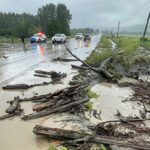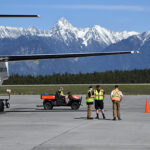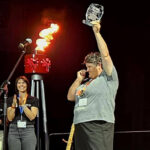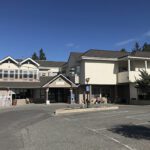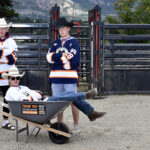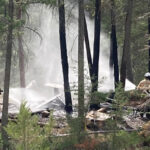Home »

Balancing conservation with recreation on Lake Windermere
 Faces & Places: Shannon McGinty
Faces & Places: Shannon McGinty
Story by Nicole Trigg
Kootenay Conservation Program
Lake Windermere is the most heavily used body of water in the entire Columbia. This shallow widening of the Columbia River stretching from near Fairmont Hot Springs to Invermere is a water recreation playground, local economic driver, and a source of drinking water while providing important habitat for plants, fish and wildlife, including at-risk and endangered waterbirds.
Balancing recreation with conservation is the role of the Lake Windermere Ambassadors (LWA), the water stewardship group that has been monitoring the ecological health of the lake since its inception in 2010, and LWA Program Coordinator Shannon McGinty couldn’t be more perfectly qualified for this challenge.
Shannon, who joined LWA in late 2018, holds a Bachelor of Science in Outdoor Recreation and Conservation from the University of Northern British Columbia (UNBC). She moved out west from her “very” small hometown in Ontario specifically for this program.
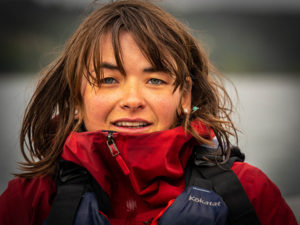
“The combination is what drew me in. When I was applying for schooling, the UNBC program was the only one offering recreation and conservation, balancing both as the main focus,” she said. “I grew up camping and doing a lot of outdoor rec, and it was always a message through my life that I should work to protect nature. When looking at school, I was looking for something that would be in line with that value and give me a launching point to be able to work in the field.”
In late 2020, the Ambassadors released the State of the Lake Report, a 10-year review of LWA’s water quality monitoring and related activities on Lake Windermere. LWA engaged the BC Lake Stewardship Society (BCLSS) to undertake this review with the assistance of Shannon and Georgia Peck, who stepped in as LWA program coordinator last year while Shannon was on maternity leave.
“The report was in two parts,” said Shannon, who secured funding for the report and hired the contractor. “One being the last 10 years of data that the Ambassadors have been collecting and comparing that to the water quality objectives that were set by the province for Lake Windermere specifically, and the other seeing how our program is doing and where we can improve, and how the water quality itself is doing as well.”
Overall, the BCLSS contractor was impressed with the depth of the programming, reaffirming LWA as an exemplary water stewardship group in the province.
“It’s more than what any of the other volunteer groups that he tends to work with are doing. He was really impressed with what we’ve been be able to do and take on. His overall impression was the improvements we could make to the program while not huge, would make major improvements.”
BCLSS was satisfied with the water quality and the general state of Lake Windermere and didn’t see any major threats in terms of spikes in phosphorus and the like.
“But in the same breath we need to do a bit more monitoring, and tweak our program a bit, to make sure that we’re really capturing all the information,” said Shannon. “For example, one thing we’ve never looked at is the under-ice conditions in the winter.”
Of the 10 recommendations that came out of the report, LWA has already begun acting on eight, including taking initial steps to improve their sampling program through auditing, ensuring strict compliance with water quality objective parameters, and better field practices.
“We are really committed to improving the program,” Shannon said.
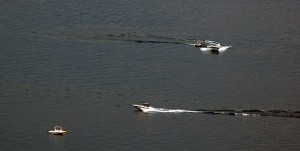
Like other outdoor destinations, Lake Windermere saw a surge in lake traffic last summer as more people turned to outdoor recreation as a safe activity amid the COVID-19 pandemic. With winter on its way out and summer on the horizon, the Ambassadors are gearing up for a busy public education and outreach season in 2021 while continuing with their regular water monitoring programs.
The LWA COVID-friendly summer kids camp will be back (pending public health regulations) one day a week, teaching kids aged 6-12 water stewardship education in a fun way. Shannon is looking at ways to keep volunteers engaged through video demonstrations and weekly creek monitoring (since their usual practice of bringing volunteers out on the lake in a boat to help with the monitoring activities will be suspended for another year).
The Ambassadors will also continue to distribute Green Boating Guides, both at the local farmers’ market and at different boat launches around the lake.
“I think one of the biggest concerns we see from boats right now is the disturbance caused by the wake-style boats because the depth of Lake Windermere three to four metres on average. Those boats are actually not meant to be used in lakes that are less than six metres deep because the wake is hitting the bottom of the lake and producing a lower quality wave. While I’m not particularly concerned about the wave quality, I am concerned about the negative impact on the lake by stirring up sediments,” Shannon said.
“The impact of high-powered boats is also seen on shoreline erosion, and with waterbirds, by scaring them from their breeding and nesting grounds. We’re still learning about it, but it’s definitely on our radar as something we’re incorporating into our education and spreading awareness about.”
The Kootenay Conservation Program (KCP) is a partnership of 80 organizations that work together to protect clean water, conserve important wildlife habitat, and steward the land to allow for healthy, functioning ecosystems in the East and West Kootenay. Learn more at www.kootenayconservation.ca.
Lead image: Shannon McGinty takes a depth measurement in Lake Windermere. Photo by Pat Morrow
Kootenay Conservation Program
